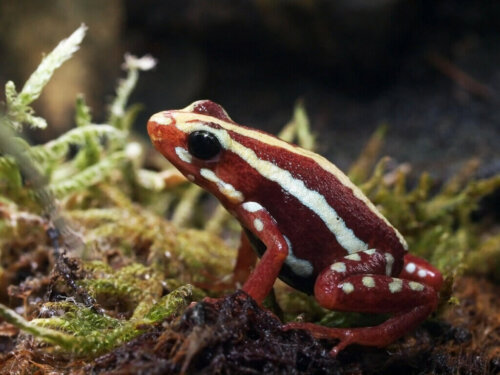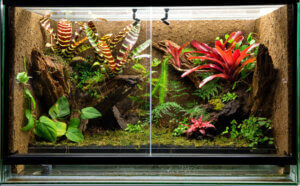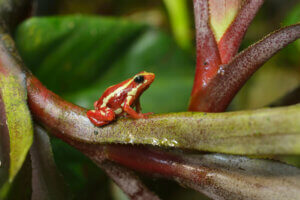Phantasmal Poison Frog: Care and Breeding in Captivity

The phantasmal poison frog (Epipedobates tricolor) is a species endemic to central Ecuador, and it stands out due to its tiny size and bright colors.
Currently, wild populations of this species are cataloged as vulnerable by the International Union for Conservation of Nature (IUCN), due to agrochemical contamination of water channels and loss of habitat by deforestation for agricultural and livestock practices.
Despite this, there’s a great interest in the captive breeding of this species. Because of this, it’s available as a pet in many stores specializing in exotic animals. If you plan to adopt some of these fascinating frogs, this article is for you.
The phantasmal poison frog
We are looking at a small frog of about 20 millimeters (0.8 in) average length. It’s dark red with yellow markings in the form of continuous or fragmented stripes from the tip of the snout or from the back of the eye to the groin. The belly may have yellow spots or be completely red.
The phantasmal poison frog lives in Ecuadorian forests near streams, so it needs a lot of moisture in its habitat. A curious fact is that the aposematic coloration of the Epipedobates serves as a warning signal for predators, as it has no other defense mechanisms but its dangerous appearance.
One species that the phantasmal poison frog can be mistaken for is Anthony’s poison arrow frog. The latter differs, among other things, by being larger and having cream-colored stripes instead of the bright yellow stripes of the phantasmal poison frog.
Caring for the phantasmal poison frog
Caring for these frogs is similar to caring for amphibian species, i.e. other frogs, of the family Dendrobatidae. The enclosure should be large and resistant. It should also imitate the natural habitat of the species.

What should the terrarium look like?
As a general rule, the larger your pet’s terrarium, the better. The most common amphibian enclosures are made of glass, acrylic, fiberglass and other synthetic materials. These materials are non-porous and easy to clean. They should all have well-fitting but breathable lids, such as those built with mosquito netting.
For a pair of frogs, small terrariums of 60 liters (2 ft3) work well. If you’re going to extend the frog family, you’ll have to slightly increase the size of the enclosure.
There are several types of substrates recommended for amphibians, and you can use a specific one or mix them. All materials listed below are excellent in retaining moisture:
- Coconut fiber
- Peat
- Sphagnum moss
- Orchid substrate
- Potting soil, always without chemicals or pesticides
- Rocks, gravel and sand
You should also include in the shelters for the frogs in the terrarium, such as wood, pots, leaf litter, branches, trunks and rocks. Finally, it’s necessary to place plants such as pothos, ferns, ivy, mosses, or bromeliads in the terrarium. These plants help retain moisture and act as natural environmental enrichment.
Environmental conditions for the phantasmal poison frog
Amphibians absorb all, or almost all, the water they need through their permeable skin. They also get some oxygen through skin breathing. For this reason, it’s very important to maintain optimal humidity in any enclosure that houses amphibians.
With a hygrometer you can check the humidity of the enclosure of your phantasmal poison frog. This must maintain a high humidity between 85% and 95%, a value similar to that in the equatorial forests this species comes from.
To achieve this humidity, it’s best to buy a humidifier or an automatic nebulizer that sprays water every 6-8 hours, but you can also do it manually. The terrarium substrate should always be moist, but not soaked.
The temperature should also recreate the conditions of the frog’s natural ecosystem. The terrarium should be 25–28 °C (77–82 °F) during the day and 20–24 °C (68–75 °F) at night. The light and temperature cycles are very important for maintaining the animal’s health.
UVB and infrared bulbs are good options for creating these cycles, but aren’t entirely necessary for amphibian rearing. You’ll also need a thermometer — digital is better — to get to know the temperature in the terrarium.
Diet
Like all other members of the dendrobatids family, these small frogs are insectivorous. Their diet consists of ants and small insects such as flies, termites, beetles and small crickets, fruit flies, weevils, springtails and other very small live invertebrates.
In specialized pet stores, you can get specific food supplemented with vitamins, such as calcium, magnesium and vitamin D. These are very important for the maintenance of the amphibian. This mix is sold as powder, and should be added to its food once a week.
Reproduction of the phantasmal poison frogs
It’s not easy to differentiate the sexes of this species. However, the female may be larger than the male, and the latter sings, but, otherwise, they’re very similar. In addition, amphibians’ reproduction cycles are generally closely linked to their physical and biological environments.
Therefore, to satisfactorily breed these animals, you’ll have to manipulate the environmental conditions of the terrarium —such as temperature, humidity and photoperiod— according to the annual cycle of the species in order to coincide with its reproduction period.
The phantasmal poison frog lays eggs on leaf litter or on large leaves of plants, so if you want them to breed, make sure they have enough vegetation.
In this species, it’s the male who takes care of the clutch, and transports the tadpoles to places with flowing or standing water where they complete their development.

These are the general guidelines for looking after the phantasmal poison frog. However, you can apply them to other similar amphibians of the dendrobatids family, and also poison arrow frogs. Always remember the importance of keeping the terrarium at the right temperature and humidity in order to keep your frogs healthy!
All cited sources were thoroughly reviewed by our team to ensure their quality, reliability, currency, and validity. The bibliography of this article was considered reliable and of academic or scientific accuracy.
- IUCN SSC Amphibian Specialist Group. 2019. Epipedobates tricolor. The IUCN Red List of Threatened Species 2019: e.T55239A98647137.
- Coloma, L. A., Frenkel, C. y Ortiz, D. A. 2019. Epipedobates tricolor En: Ron, S. R., Merino-Viteri, A. Ortiz, D. A. (Eds). Anfibios del Ecuador.
- dntaecosistemas
- Guía para el Manejo de Anfibios en Cautiverio. Amphibian Ark. Association of zoos & Aquarium.